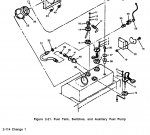- 3,812
- 5,888
- 113
- Location
- MA
Ok so I got a little bit of time earlier to pull some sheet metal on both machines. In looking at the documentation in the -24 on this, the float tube and the low fuel level/auxiliary fuel pump float switch appear to be separate units (one installed in the other)... but what I pulled out seems to be a single device? I didn't want to be a jack@ss and just assume its a two piece assembly like the line drawing shows, and start yanking to separate them.
For those that have dealt with this particular component before... whats the scoop? It appears the wires are potted into the top of the device, and my assumption is that its wired down to an internal sensor at the end of the tube assembly. Hats off to the engineers who designed captive nuts on the front end of these generators! Would it have killed them to use them across ALL the sheet metal??
For those that have dealt with this particular component before... whats the scoop? It appears the wires are potted into the top of the device, and my assumption is that its wired down to an internal sensor at the end of the tube assembly. Hats off to the engineers who designed captive nuts on the front end of these generators! Would it have killed them to use them across ALL the sheet metal??



